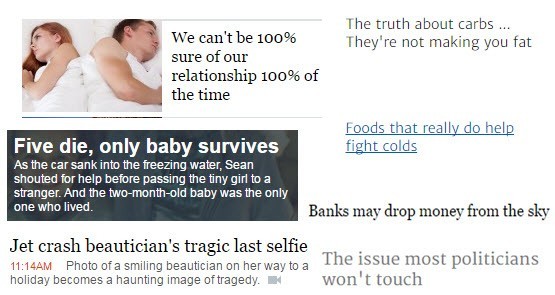
As Fairfax journalists try to avoid swingeing cuts to their newsrooms, there is another insidious enemy lurking to take down good journalism: clickbait.
Clickbait is hurting Fairfax more than it realises. The mood among readers, former readers and potential readers is not just negative but aggressively so.
Online, people say it is:
- “… just a link aggregator now”;
- “… just a real estate spruik pamphlet”;
- “… rubbish”; and
- “… shit posing as drivel posing as journalism.”
All those comments are unfair. But Fairfax is busy chasing clicks. It is in a tight race with News.com.au to have the biggest news site in Australia, and it aims to do that with a lot of content designed to be clickable, like this story, on the homepage yesterday: “How many girls are there? The photo driving the net wild.”
The experience was unedifying, and I shudder as I think about the effect it is having on the reputation of The Age — the newspaper I grew up with. Each cheaply sourced story has a spill-over effect on the other content that is amplifying by the day.
Every click is valuable to Fairfax, of course. But some clicks have more cost to the masthead than they do value to the advertisers. Right now, Fairfax’s big legacy brands are at a tipping point, and they must make sure they do not burn the goodwill accumulated over so many decades.
How has it come to this?
The editors of the paper perhaps read only the well-researched stories produced by Fairfax’s stable of great writers, and they are reassured the quality of the masthead is still high. But if that is the case they are missing a vital sense of how the reputation of a masthead is formed.
Much news these days is found without going through a masthead. People find links on Twitter and Facebook. Mastheads are in a battle for relevance. The idea they will thrive without investing in their brand image is crazy.
A masthead is nothing but a brand. It works like a promise. It says “what you find here will be good”. For The Age and SMH, “good” means a certain level of intellectual seriousness is achieved.
Coca-Cola doesn’t just shove sugar into our faces; it dresses it up in a package that alludes to our aspirations; it makes us feel good about drinking the calories.
Prominently publishing serious articles is a good way of making your brand seem serious.
I wrote for the Fin Review for a few years, and they were big on boring stories. I wrote some real yawn-fests about the number of 20-foot equivalent unit (TEU) shipping containers traversing the Port of Melbourne. While very few actually read those stories, you couldn’t find anyone who would say a bad word about the paper. Everyone agreed it was important.
And that gives you licence.
Inside a publication people perceive as very serious, some less serious writing can be very well received. Lucy Kellaway’s management columns at the Financial Times are a great example. Always brilliant but quite light and fun, they’d be seen rather differently if they were published in The Sun. It’s like the chocolate ice cream at a Michelin restaurant. The three stars on the door give you permission to enjoy the calories with a sense of simple delight.
The Age and SMH needn’t go to the other extreme and publish only serious stuff on state politics and business. They can still publish some light material designed to win clicks.
But it is clear: there needs to be less of it. Soon.








I don’t know why you say the negative comments about the website are unfair. They seem right to me, andI have read the Sydney Morning Herald for over fifty years. The newspaper is not a patch on its former self, and the website is tabloid rubbish; it makes me feel grubby to read it. Unfortunately the management seem hellbent on prioritizing the website over the paper, and rating journalists by the clicks on their stories, which is a recipe for a race to the bottom.
This piece is so true.
The other self-harming aspect about clickbait headlines is that they are specifically designed to trick readers. Readers notice when they have been decieved. Thus they achieve the very opposite effect of the trust that has traditionally been at the heart of newspaper brand-building.
And what does it say about how management views its readers?
I was pretty close to ending my Fairfax subscription anyway – specifically because of clickbait – but the final straw was when I left a polite, but critical comment on a news article with a deeply misleading clickbait headline … and they moderated the comment away.
Well, screw them too.
Well said. Fairfax’s strategy is suicidally ill-advised. They have, or had, a respected brand which pre-dated the digital age and which might still serve as a beacon on the oceanic trash-gyre that is the internet. Instead they’re choosing clickbait route. It’s tragic because Fairfax is nothing less than essential for the functioning of democracy in this country. So, probably, is Newscorp, though it corrodes my fingertips just to type that.
The endless stream of clickbait shite has driven me away from The Age for good. Wankers.
Why haven’t they firmed-up their Paywall? Still lots of good content their that people will want. Just make make it super easy to subscribe.